Posted by Nodus Labs | April 2, 2023
Competitive Intelligence and Market Research with GPT-3 AI and Networks
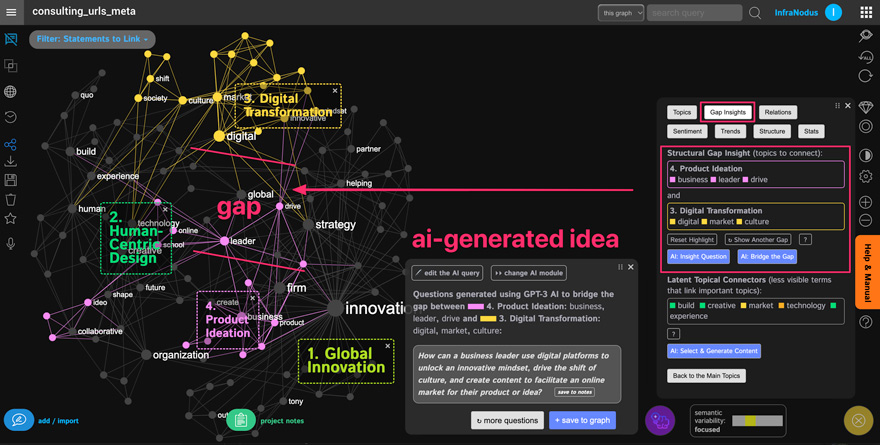
Studying market discourse is an important part of a competitive intelligence cycle and market research. In this article, we will present a methodology you can use to leverage text network analysis and GPT-3 AI to better understand your competition and customers. You can apply this methodology to your own data using the InfraNodus Marketing Research app.
We will use a real-life example of market research itself, studying the products and companies that are currently present, as well as the current demand for information, and customer sentiment. We will show how you can use advanced AI tools to reveal high-level ideas in any market, understand the strong and the weak sides of your competition, as well as get the gist of what the customers are saying about a product or service. In the end, you can use these insights to generate a market research report, which you can then integrate into your marketing strategy.
1. Understand the Current Informational Demand (Search Intent)
To begin our study, we will first try to understand the current demand. The best way to do that is to use a well-known SEO strategy of analyzing the search intent for the domain that we’re interested in. It works by extracting “suggested queries” from Google for a certain request in order to understand what people look for when they are thinking about a product or service:
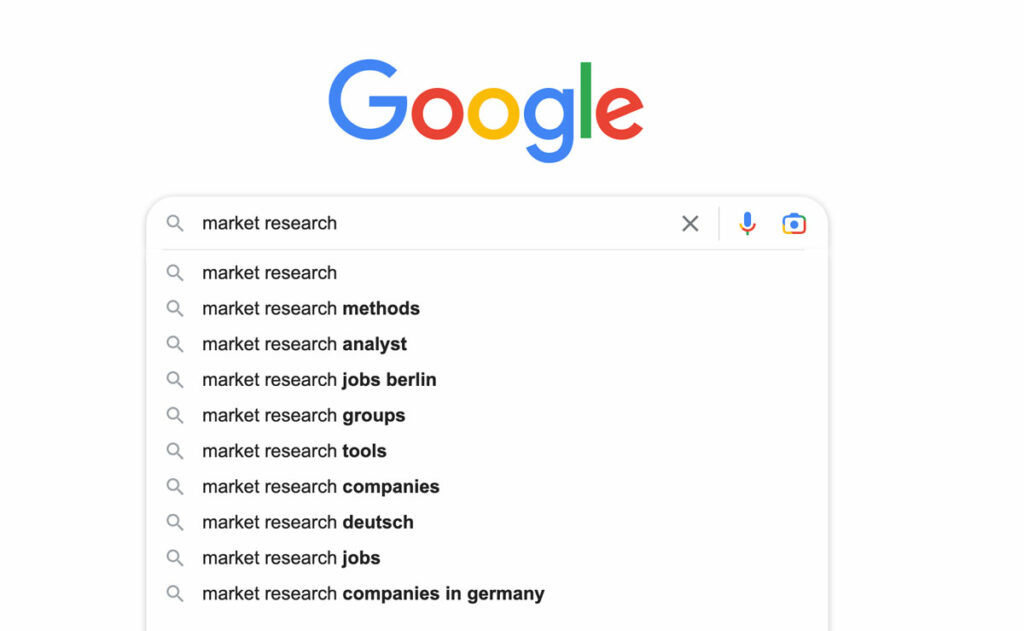
As we can see, people search for jobs, but also for tools, and companies that can provide / offer the service. In fact, Google has hundreds of suggestions hidden under the hood and InfraNodus has a special Keyword Analysis app that extracts 200 most popular suggestions for related search queries, so we get a graph like this:
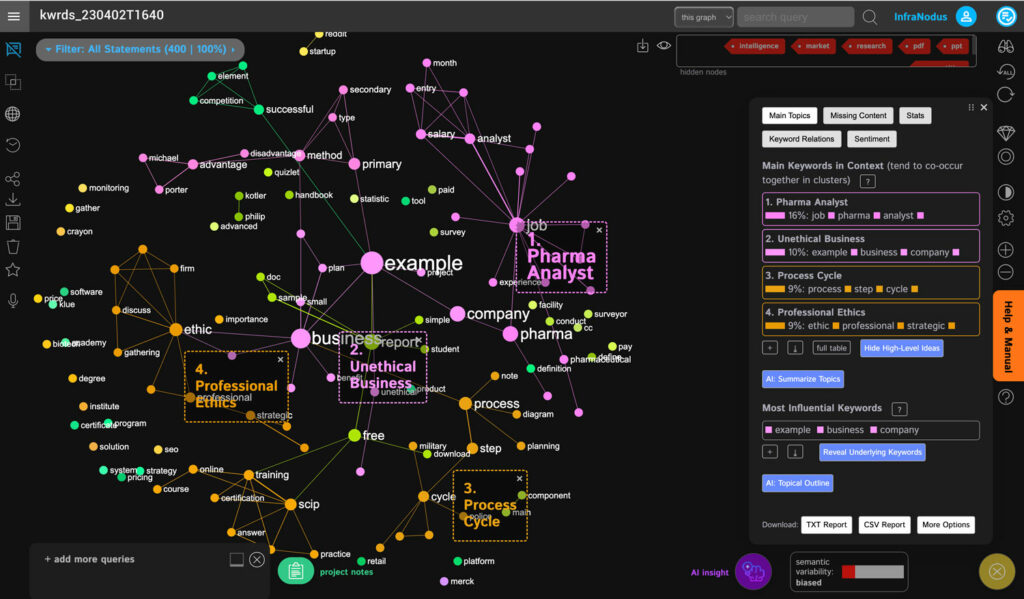
The visualization above, created with InfraNodus Keywords Analysis app, extracted the most typical search queries for “market research” and “competitive intelligence”. We then hid these words from the graph in order to see the context around them. We use built-in GPT-3 AI to generate high-level ideas that describe the main topics that emerge in these search intents:
- job / pharma / analyst (Pharma Analyst)
- example / business / company / ethical (Unethical Company)
- process / step / cycle (Process Cycle)
- ethics / professional / strategic (Professional Ethics)
As we can see, there’s quite a lot on ethics and pharma, which means that this topic is especially interesting for the pharmaceutical industry and there are also plenty of requests about ethics, which means that this topic is important as well. Additionally, people are interested in examples, reports, and step-by-step guides of how market research and competitive intelligence are conducted.
Actionable insight: the product we offer should cater, among others, to the pharmaceutical industry. We should communicate our ethical approach, and also be specific about the methodologies and steps we use in our market analysis cycle.
2. Study the Current Informational Supply
The next step is to understand the current informational supply. We do that by studying Google search results for our domain. InfraNodus has a Google app, which visualizes the top 40 search results and shows the main topics contained inside. This helps us see what people actually find when they search for “market research” and “competitive intelligence”:
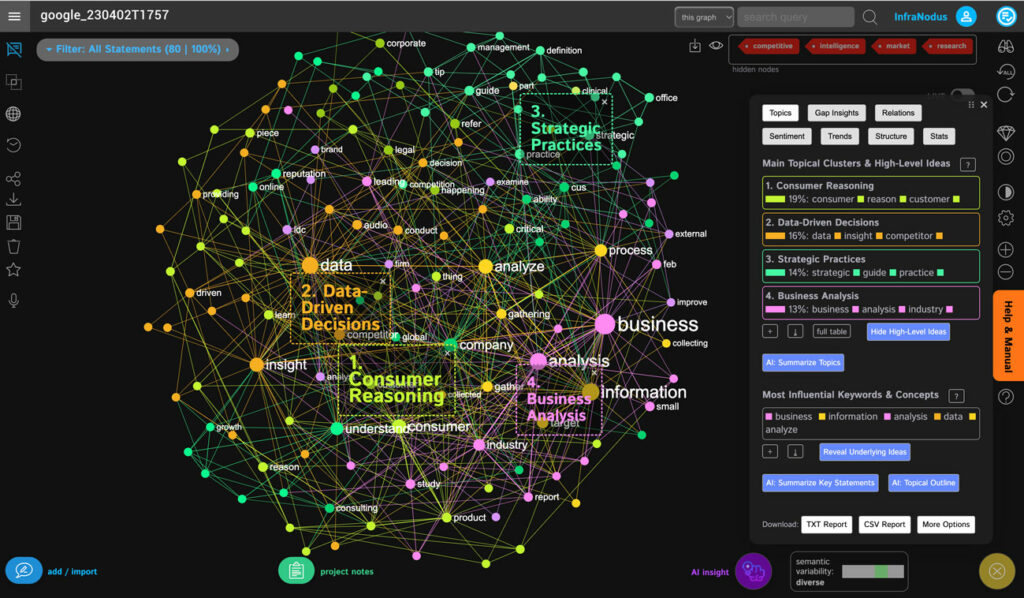
As we can see, the main high-level ideas and concepts shown to people interested in these subjects are:
• consumer reason customer (Consumer Reasoning)
• data insight competitor (Data-Driven Decisions)
• strategic guide practice (Strategic Practices)
• business analysis industry (Business Analysis)
This gives us a pretty good idea of the current informational supply: most of our competitors will be writing about analyzing customers, using data insights, offering guides to strategy, and talking about business analysis.
If we wanted to enter this discourse, we would probably focus on a combination of those, but try to connect them in a new way, so that we come up with something original. Here’s how we can do that.
3. Reveal the Structural Gaps and Market Discourse Entrance Points
InfraNodus has a special Insight Analytics panel that shows us the structural gaps and the best discourse embed points:
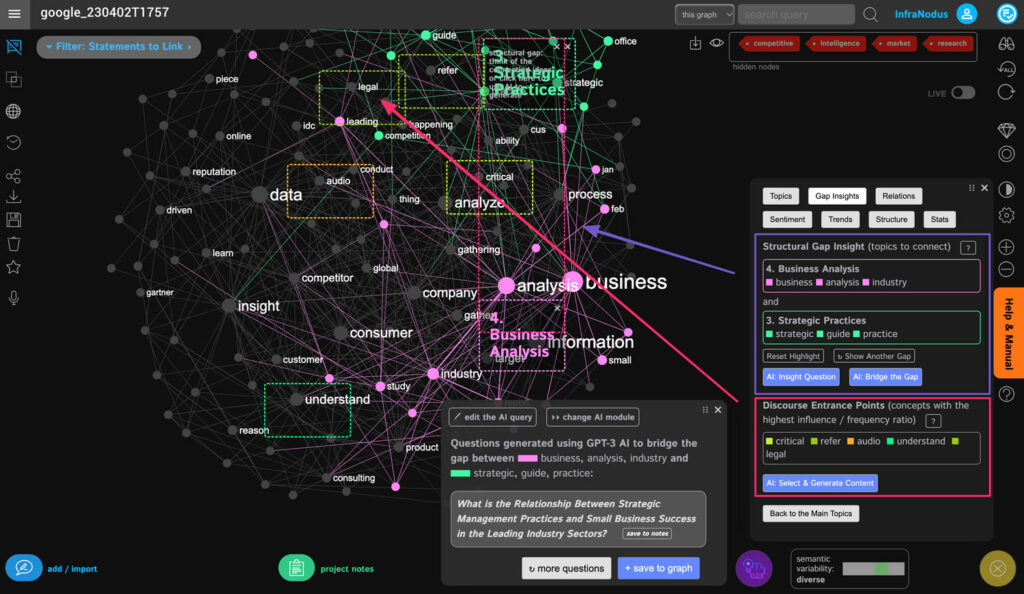
We can target those to create relevant and innovative content.
As we can see above, InfraNodus detects a structural gap between “business analysis” and “strategic practices” proposing us to think of a connection between them. GPT-3 AI generates a research question that can bridge those together: “What strategic management practices can be used by small businesses to reach success”. We could add this idea into our offering and provide a section on using strategic business analysis for small business operations.
Additionally, we also identify the most effective discourse entrance points (highlighted on the graph). Those are the concepts that have higher influence even if they are not mentioned frequently. These concepts are conducive for embedding into this discourse as they are not congested by meaning but are, at the same time, well integrated. In our case, one concept is interesting: “legal” — we can see that perhaps competitive intelligence for legal consulting can be an interesting niche to explore.
Actionable insight: make an offering for small businesses and also explore market research in the legal context
4. Compare Demand and Supply, Reveal What’s Missing
The next step is to compare the informational demand and supply. We can see what people search for but do not find. To do that, we use the graph comparison feature in InfraNodus (Compare how Google Search Results is different to the Keyword Suggestions) and we will see the concepts that are present in the keywords suggestions graph but not in Google search results:
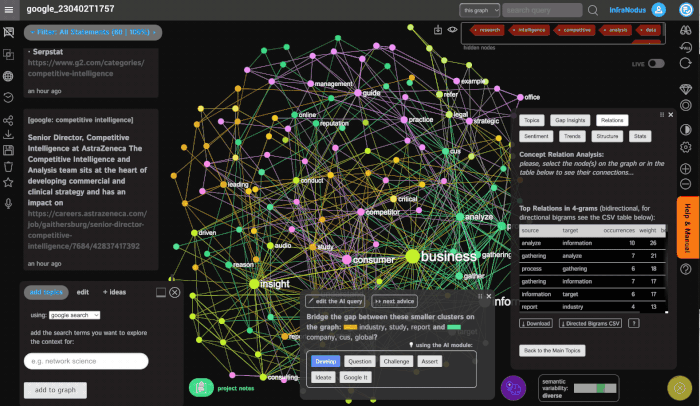
As we can see, the concepts of “cycle” and “ethics” are missing from the informational supply. This could be an interesting niche for us to address in order to make an offering that is relevant for the market and yet adds something that’s missing from it.
Actionable insight: In our particular case, we could make a bigger emphasis on ethical marketing and competitive intelligence practices. We could also talk more about the whole competitive intelligence cycle explaining in detail the steps that our company takes to perform market research.
5. Study Competitors’ Websites
In order to understand the market discourse better, we can study the discourse of a few companies that already offer the service. In this case, we found 20 websites for small consulting agencies and imported their home page using the InfraNodus URL analysis app. It visualizes the content of those pages and shows us the high-level ideas and topics present on all of them:

As we can see, these companies talk about innovation, digital transformation, and product ideation a lot. We could integrate it into our offering. We could also use the “Structural Gap” detection in order to better understand what they’re not talking about it. We could then use this insight to modify our original discourse and to include some elements that are not yet present in the general discourse.
6. Study Customer Reviews
The final step is to find customer reviews for the competitors’ services and products and use the Sentiment Analysis app in InfraNodus to understand what they’re talking about.
It is particularly interesting to see what the customers are saying when they talk negatively about a product, so that we can better understand the current lack and address it somehow.
Read more about customer review analysis in our sentiment analysis article.
…

